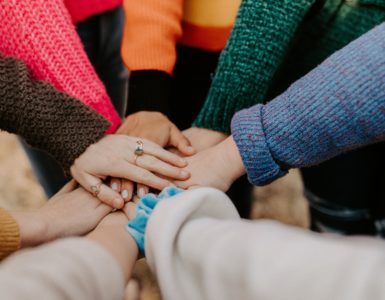One year I had a student that was a late addition to my preschool classroom in Washington DC. The student came into my classroom and that day I learned that he was new to the country. On a normal day while lining up for recess, the child acted out emotionally. He screamed and shook when a teacher was giving him a direction with a reasonable, firm tone. For me, this was a red flag and we suspected trauma in his background.
My principal spoke with the student’s mother to get to know her, and she tearfully shared her story about coming to the U.S. with her family as refugees. The family fled Iraq to seek a new life in America, leaving their jobs, families, and way of life. As we spoke to her, it made me wonder, do I really know about refugees? How many refugees have I met over the years who kept their past silent due to trauma in their home country?
After my interaction with this student, I learned that a couple of my students were refugees and their backgrounds were very different as far as status in the U.S. Some of the students sought status and came here with all of the paperwork, and some students came here by foot with their families. One student I knew of was actually in a refugee camp.
There are times that there is a need for the students to be adopted or to be placed in foster care until their parents’ affairs are in order. I believe that before fostering or adopting a child who is a refugee, it is important to understand what “refugee” means. It is my hope for you to gain some awareness and understanding into refugees and how they can fit in the foster care/adoption process in America.
Who Are Refugees?
According to the United Nations High Commissioners for Refugees (UNCHR), refugees are people who fled “war, violence, conflict or persecution” and crossed an international border to find safety in another country. These people are forced out of their homes and at times travel by land to get to another country. Typically refugees are leaving behind everything—homes, jobs, families, their way of life—to find a new life elsewhere. A refugee does not wish to return home out of fear of persecution. According to the 1951 Refugee Convention, reasons for this include “race, religion, nationality, war, ethnic or political violence, membership of a particular social group, or political opinion.” By the end of 2017, UNHCR documents that there were 25.4 million refugee men, women, and children registered around the world.
The number of people forced to flee their homes because of conflict and persecution alone has steadily increased. The major crises around the world that contributed to the increase in refugees are the ongoing conflict in Syria, the conflict in Afghanistan, South Sudan’s displacement crisis following its independence, and the violence in Myanmar’s Rakhine Stake that began in 2017, which forced over a half a million ethnic Rohingya to flee their country.
What Are Refugee Camps and Why Were They Created?

There are times that the host country accepting the refugees places them in camps. The host country wants to do this until they can decide how to help the refugees either properly immigrate into the host country or resettle back into their home country.
According to Save the Children, refugee camps are “temporary settlements” founded to provide refugees with shelter, emergency relief items, water, sanitation, food, healthcare and counseling, and registration and legal aid. Forced from home, refugees are often left with little to call their own.
The picture above was taken by photographer Siddhant Soni. It is honestly one of the first pictures that I’ve ever seen of children in a refugee camp. This picture was taken in India, but there are other refugee camps all over the world. Some of the largest refugee camps are in Bangladesh, Uganda, Kenya, Jordan, Tanzania, and Ethiopia.
The average amount of time that refugees spend in the camps varies depending on the reason that the families are leaving their country. According to Save the Children, if there is a mass displacement, then refugees may spend years and even decades living in a camp. If families live there for decades, then generations grow up in the camps together. For me, to think about being stationed in one camp for that length of time is truly astounding. Despite being in these camps, the trauma that children experience throughout their childhood is very significant.
Once people are in the camps, they wait for asylum from European countries and beyond. The photo above is of a Syrian refugee camp in the outskirts of Athens. She adds that beginning in 2011, over 6.6 million Syrians fled their homes against their will. Many of them are still stranded in camps in Turkey and Greece waiting (and hoping) to be granted asylum in European countries or beyond.
The Resettlement of Refugees
According to UNHCR, the U.S. is one of 29 resettlement countries. Sadly, out of 26 million refugees, only 1% of them are considered for resettlement worldwide. Refugee status is acknowledged by the United Nations. Most refugees who enter the U.S. refugee program are referred for resettlement in the U.S. by the U.N. refugee agency (UNHCR), a U.S. embassy, or an approved humanitarian aid organization.
The U.S. accepts only a limited number of refugees. Applications for refugee admission to the United States must satisfy the following criteria:
1). Meet the definition of a “refugee” as determined by the U.S. government. This only happens if the government declares that you are from a war-torn country and you are not safe in your own country.
2). Not admissible under U.S. law.
3). Not resettled in another foreign country.
Refugees and Adoption
I admit that I am a bit embarrassed that my first exposure to the term “refugee” was at age 31. My husband and I were going through our classes needed to foster a child in Washington D.C. The agency wanted more families to adopt refugees who were coming into the country. These children were coming without their parents for many different reasons, such as if their parents had died or they were coming to the country before their parents.
According to Jennifer Jones’ article How Can I Adopt Syrian Refugees?, for the United States to approve the adoption of a foreign child, the child must be an orphan. This may be a problem because some children who are refugees may appear to be orphans but are just separated from their parents. There is a struggle to reunite them with their families and their communities, and this keeps the child waiting and waiting to have a family.
Once these children are admitted into the US, they go through the resettlement program. These children are placed in licensed foster homes. The foster parents come from diverse ethnic and linguistic backgrounds and have received special training on the adjustment needs of refugee youth.
Foster care managers assist in finding special services that are needed for the child to settle successfully into the United States. Examples of services are English language services, family tracing, and therapy for trauma. I remember that for my former student, he was able to get educational services while he was waiting for his parents to complete their paperwork.
Refugee minors are typically long-term foster placements, unless they are reunited with their families. Similar to domestic foster care, family unification is the goal. If family unification can not happen, then the child can be placed for adoption.
Children Refugees and Trauma
According to Save the Children, there are 426 million children who live in conflict zones. Children grow up similar to my former student, living in constant fear because their circumstances cause their childhood and safety to be taken away. Raising a voice or making a sound can be a trigger for a child to react emotionally. My student on his first day of school flinched and shook at the sound of the teacher’s voice. It was heartbreaking. I could not imagine what he experienced in Iraq and what he was working out emotionally while in safety.
Save the Children adds that trauma from conflict is toxic to children’s social and physical development. The impact of conflict on children varies by age, gender, status, ethnicity, religion, and disability. Children who live in conflict zones experience hunger, loss of education, and lack of safety and basic resources. These things stunt their developmental progress significantly.
Additional Resources about Refugees.
Here are various organizations that help with educating others on the refugee crisis.
United Nations High Commissioners for Refugees (UNCHR)
Karen Spencer is World Relief’s U.S. Marketing Partner and serves U.S. offices in the area of identity and messaging. She gathered a list of resources that give firsthand accounts of refugees and displaced people from around the world. This information can help others experiencing the refugee crisis around the world.
Podcast: Working a Refugee Crisis: Jordan
A 6-episode series about the civil war that broke out in Syria. This was the largest refugee crisis since World War II. There are conversations from refugees, relief workers, and aid agencies who helped the crisis in Jordan.
Podcast: Beyond Soundbites—a Refugee Highway Podcast
Created by World Relief Chicagoland’s Jacob Mau, this podcast explores the stories of refugees and displaced people in the U.S. and across the globe.
Podcast: Bold Love with Jenny Yang
Pastor Bob Roberts Jr. talks with World Relief’s Jenny Yang about changes in refugee policy and the relationship between faith-based organizations and government leaders.
TEDxTalk: One Refugee’s Life Experience by Come Nzibarega
Born and raised in Burundi, Come Nzibarega shares his story of escaping torture and civil war. Today, Come works as an Employment Specialist for World Relief.
Book: The Girl Who Smiled Beads
When Clementine was six years old, she and her 15-year-old sister, Clair, fled the massacre that was happening in their home country of Rwanda. In this memoir, Clementine tells the story of rebuilding her life with her sister.
Book: On the Other Side of the Sky
After stepping on a land mine, Farah Ahmedi fled her home country of Afghanistan with her family and resettled in the U.S. Today, she is a writer, speaker, humanitarian, and activist. This was the first book that she wrote documenting her life.
Next Steps: Orphan Crisis
While adoption is seen as one of the solutions to the refugee orphan crisis, I believe that education and awareness of the refugee crisis are paramount in helping the refugee crisis. Ongoing advocacy, volunteering, and speaking with elected officials will help others to find safer homes. While it is noble to adopt or foster a child who is a refugee, I recommend that potential foster or adoptive families hear from other refugees and refugee organizations and go through training that will help them in living with a child who is a refugee. They might also consider joining a support group of families and advocating for families who are in the same situation.
Today, my former student is settled in the US. The school and his mother worked together to find him and his family resources to help them emotionally. His full personality is on display to us all. He is a bright, funny, and intelligent child. Despite not being his teacher anymore, I still get a visit and a prank from him and his sister. The same hope that I have for him is the same hope that I have for other refugee children: safety, resources, and community. I hope that we can all do our part to make a difference in their lives.
Are you ready to pursue adoption? Visit Adoption.org or call 1-800-ADOPT-98 to connect with compassionate, nonjudgmental adoption specialists who can help you get started on the journey of a lifetime.



